Operations Management Report: Amazon's Supply Chain Strategy Analysis
VerifiedAdded on 2020/04/21
|7
|1368
|107
Report
AI Summary
This report examines Amazon's supply chain management, highlighting its integration strategies, logistics, and competitive advantages. It discusses Amazon's medium and long-term forecasts, including investments in warehouses and material handling systems like Kiva. The report analyzes the impact of logistics, transportation modes, and warehouse locations on competitiveness, as well as the role of global sourcing and procurement in reducing costs. It also covers the benefits and challenges of outsourcing logistics, such as reduced fixed assets and improved information access, while addressing issues like compatibility and control. Furthermore, the report explores Amazon's e-commerce strategies, including social media marketing, search engine optimization, and the use of big data to understand consumer needs. Finally, it emphasizes Amazon's market leadership, driven by vertical integration, innovation, and superior supply chain management, setting an example for other companies.
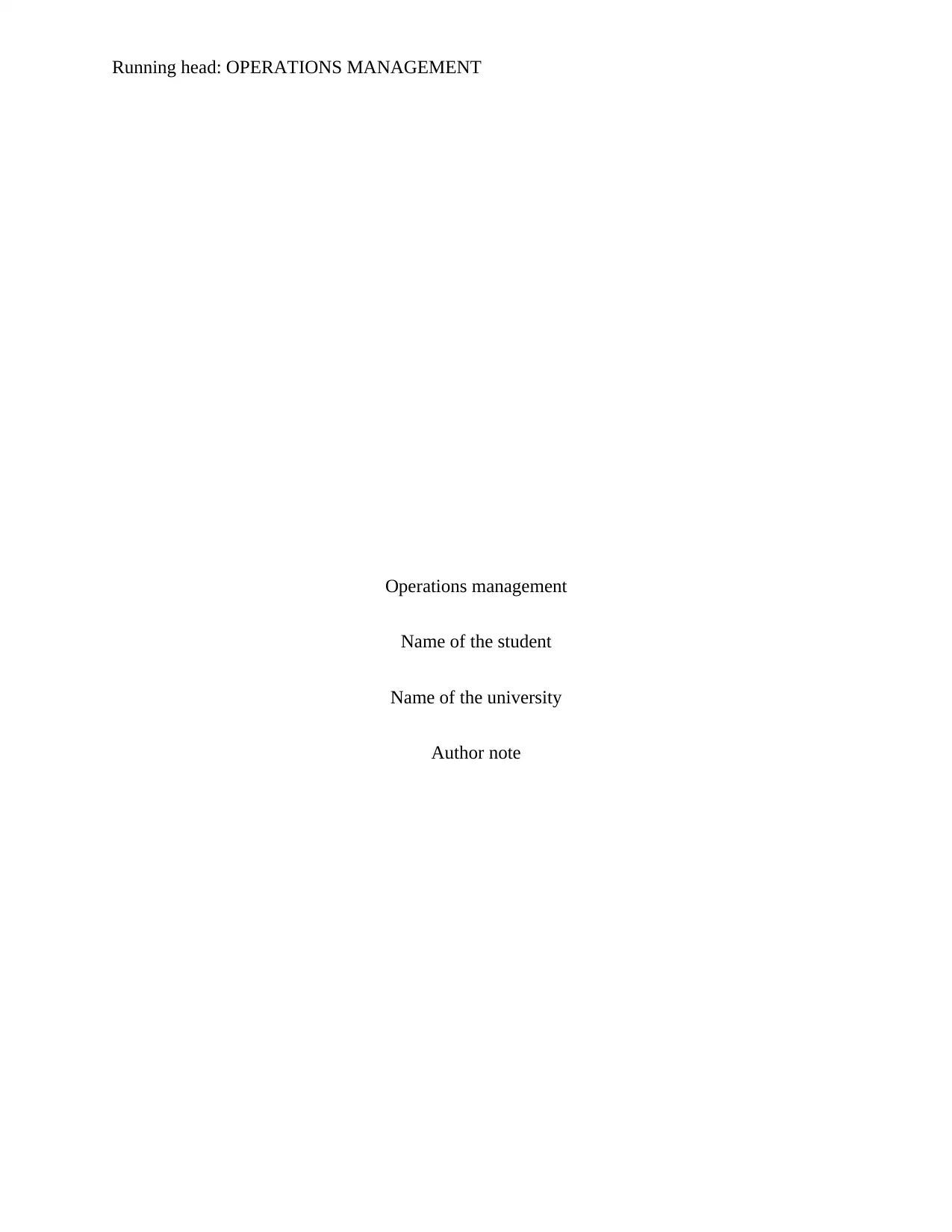
Running head: OPERATIONS MANAGEMENT
Operations management
Name of the student
Name of the university
Author note
Operations management
Name of the student
Name of the university
Author note
Paraphrase This Document
Need a fresh take? Get an instant paraphrase of this document with our AI Paraphraser
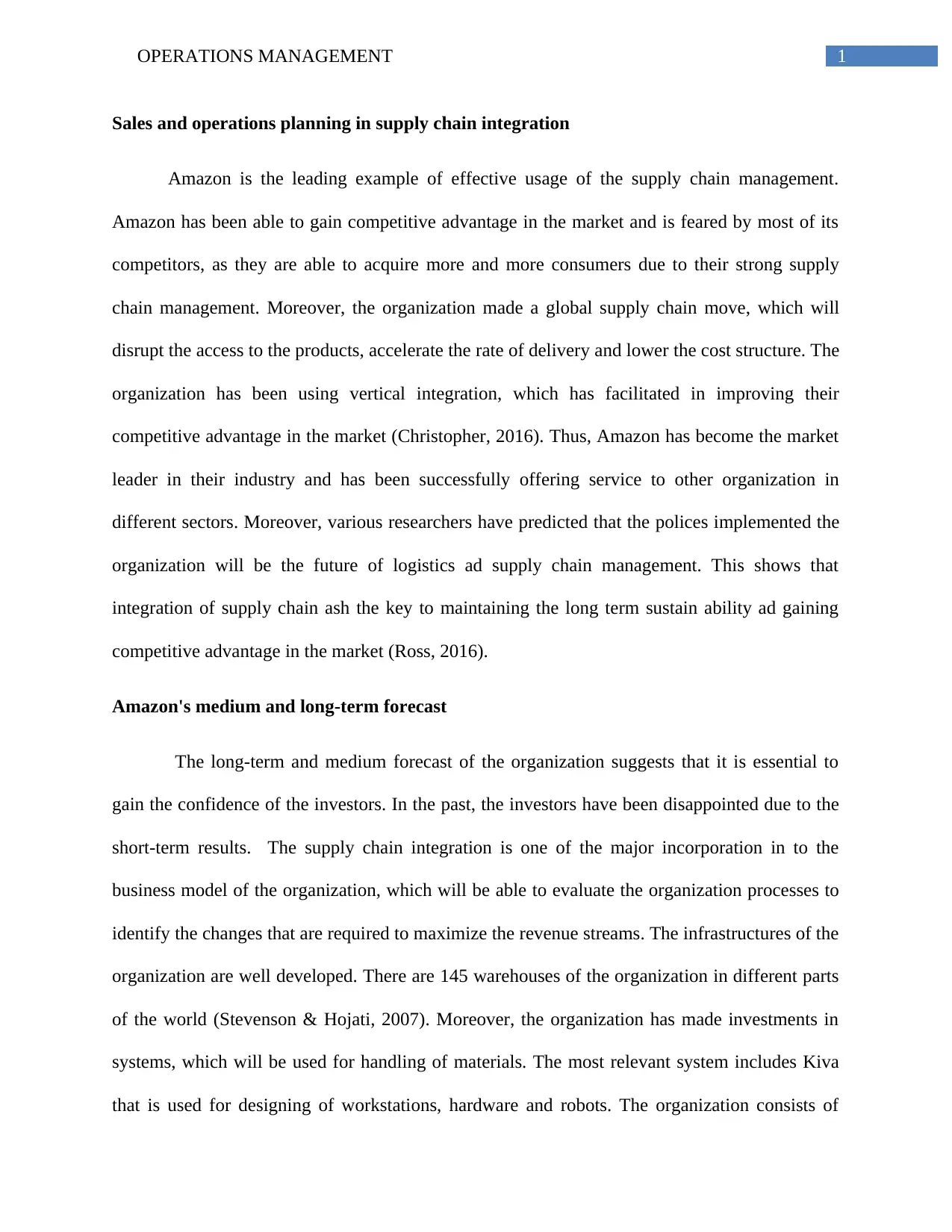
1OPERATIONS MANAGEMENT
Sales and operations planning in supply chain integration
Amazon is the leading example of effective usage of the supply chain management.
Amazon has been able to gain competitive advantage in the market and is feared by most of its
competitors, as they are able to acquire more and more consumers due to their strong supply
chain management. Moreover, the organization made a global supply chain move, which will
disrupt the access to the products, accelerate the rate of delivery and lower the cost structure. The
organization has been using vertical integration, which has facilitated in improving their
competitive advantage in the market (Christopher, 2016). Thus, Amazon has become the market
leader in their industry and has been successfully offering service to other organization in
different sectors. Moreover, various researchers have predicted that the polices implemented the
organization will be the future of logistics ad supply chain management. This shows that
integration of supply chain ash the key to maintaining the long term sustain ability ad gaining
competitive advantage in the market (Ross, 2016).
Amazon's medium and long-term forecast
The long-term and medium forecast of the organization suggests that it is essential to
gain the confidence of the investors. In the past, the investors have been disappointed due to the
short-term results. The supply chain integration is one of the major incorporation in to the
business model of the organization, which will be able to evaluate the organization processes to
identify the changes that are required to maximize the revenue streams. The infrastructures of the
organization are well developed. There are 145 warehouses of the organization in different parts
of the world (Stevenson & Hojati, 2007). Moreover, the organization has made investments in
systems, which will be used for handling of materials. The most relevant system includes Kiva
that is used for designing of workstations, hardware and robots. The organization consists of
Sales and operations planning in supply chain integration
Amazon is the leading example of effective usage of the supply chain management.
Amazon has been able to gain competitive advantage in the market and is feared by most of its
competitors, as they are able to acquire more and more consumers due to their strong supply
chain management. Moreover, the organization made a global supply chain move, which will
disrupt the access to the products, accelerate the rate of delivery and lower the cost structure. The
organization has been using vertical integration, which has facilitated in improving their
competitive advantage in the market (Christopher, 2016). Thus, Amazon has become the market
leader in their industry and has been successfully offering service to other organization in
different sectors. Moreover, various researchers have predicted that the polices implemented the
organization will be the future of logistics ad supply chain management. This shows that
integration of supply chain ash the key to maintaining the long term sustain ability ad gaining
competitive advantage in the market (Ross, 2016).
Amazon's medium and long-term forecast
The long-term and medium forecast of the organization suggests that it is essential to
gain the confidence of the investors. In the past, the investors have been disappointed due to the
short-term results. The supply chain integration is one of the major incorporation in to the
business model of the organization, which will be able to evaluate the organization processes to
identify the changes that are required to maximize the revenue streams. The infrastructures of the
organization are well developed. There are 145 warehouses of the organization in different parts
of the world (Stevenson & Hojati, 2007). Moreover, the organization has made investments in
systems, which will be used for handling of materials. The most relevant system includes Kiva
that is used for designing of workstations, hardware and robots. The organization consists of
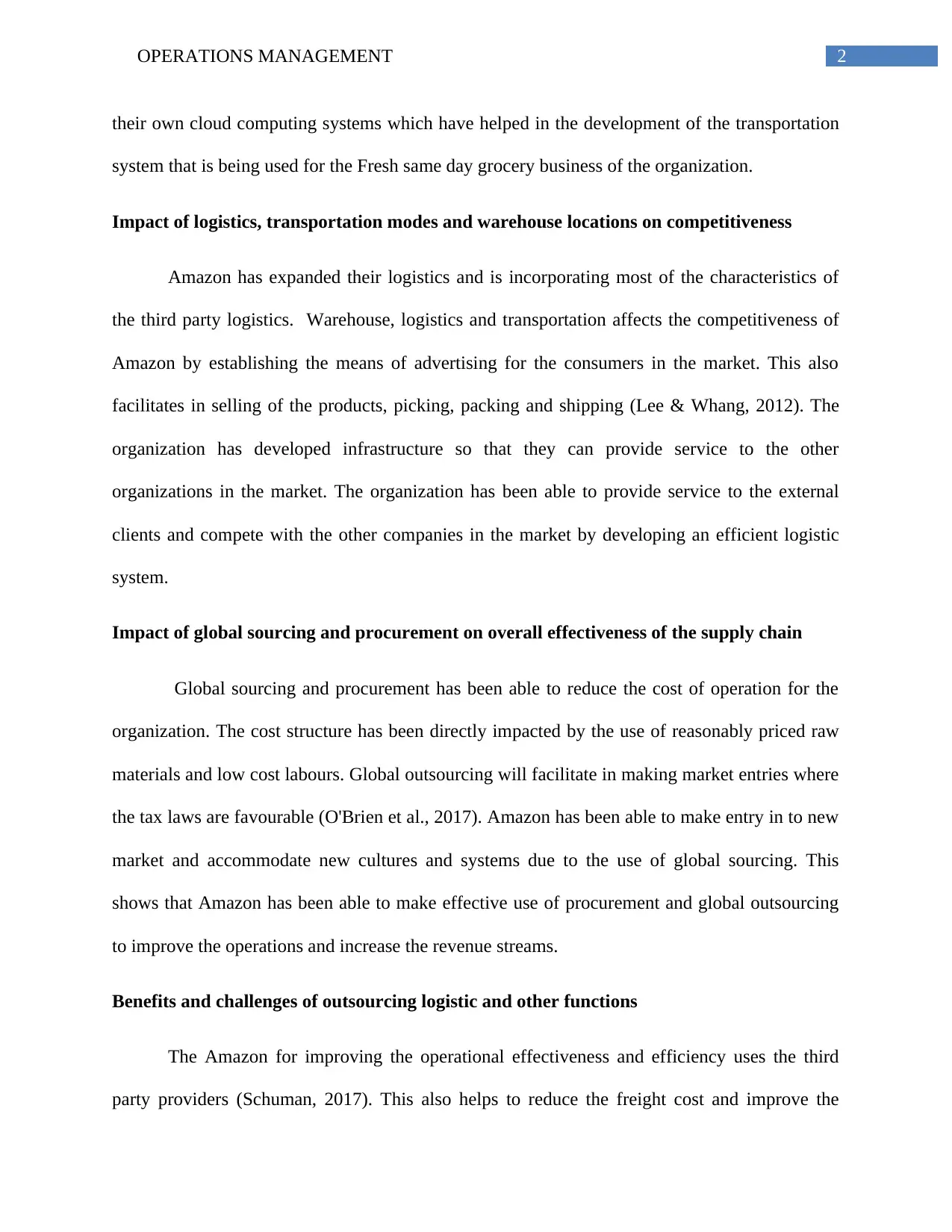
2OPERATIONS MANAGEMENT
their own cloud computing systems which have helped in the development of the transportation
system that is being used for the Fresh same day grocery business of the organization.
Impact of logistics, transportation modes and warehouse locations on competitiveness
Amazon has expanded their logistics and is incorporating most of the characteristics of
the third party logistics. Warehouse, logistics and transportation affects the competitiveness of
Amazon by establishing the means of advertising for the consumers in the market. This also
facilitates in selling of the products, picking, packing and shipping (Lee & Whang, 2012). The
organization has developed infrastructure so that they can provide service to the other
organizations in the market. The organization has been able to provide service to the external
clients and compete with the other companies in the market by developing an efficient logistic
system.
Impact of global sourcing and procurement on overall effectiveness of the supply chain
Global sourcing and procurement has been able to reduce the cost of operation for the
organization. The cost structure has been directly impacted by the use of reasonably priced raw
materials and low cost labours. Global outsourcing will facilitate in making market entries where
the tax laws are favourable (O'Brien et al., 2017). Amazon has been able to make entry in to new
market and accommodate new cultures and systems due to the use of global sourcing. This
shows that Amazon has been able to make effective use of procurement and global outsourcing
to improve the operations and increase the revenue streams.
Benefits and challenges of outsourcing logistic and other functions
The Amazon for improving the operational effectiveness and efficiency uses the third
party providers (Schuman, 2017). This also helps to reduce the freight cost and improve the
their own cloud computing systems which have helped in the development of the transportation
system that is being used for the Fresh same day grocery business of the organization.
Impact of logistics, transportation modes and warehouse locations on competitiveness
Amazon has expanded their logistics and is incorporating most of the characteristics of
the third party logistics. Warehouse, logistics and transportation affects the competitiveness of
Amazon by establishing the means of advertising for the consumers in the market. This also
facilitates in selling of the products, picking, packing and shipping (Lee & Whang, 2012). The
organization has developed infrastructure so that they can provide service to the other
organizations in the market. The organization has been able to provide service to the external
clients and compete with the other companies in the market by developing an efficient logistic
system.
Impact of global sourcing and procurement on overall effectiveness of the supply chain
Global sourcing and procurement has been able to reduce the cost of operation for the
organization. The cost structure has been directly impacted by the use of reasonably priced raw
materials and low cost labours. Global outsourcing will facilitate in making market entries where
the tax laws are favourable (O'Brien et al., 2017). Amazon has been able to make entry in to new
market and accommodate new cultures and systems due to the use of global sourcing. This
shows that Amazon has been able to make effective use of procurement and global outsourcing
to improve the operations and increase the revenue streams.
Benefits and challenges of outsourcing logistic and other functions
The Amazon for improving the operational effectiveness and efficiency uses the third
party providers (Schuman, 2017). This also helps to reduce the freight cost and improve the
⊘ This is a preview!⊘
Do you want full access?
Subscribe today to unlock all pages.

Trusted by 1+ million students worldwide

3OPERATIONS MANAGEMENT
quality of service. Moreover, they provide flexibility to the delivery system of the organization.
The benefits of outsourcing the logistics are as follows:
Decrement in the use of the fixed assets which increase the asset turn over and the
financial performance
Decrement in investment of inventory, which will improve the visibility of the inventory
The cash to cash cycle will be reduced which will increase the turnover rate of the
inventory
Reduction in the cost of logistics
Improvement in the access to information through improvement in the information
technology services
The challenges faced due to the outsourcing of the logistics are as follows:
Inability to convene the requirement of the organization
No compatibility among the organization and the third party provider in respect to the
information technology
Inability of the third party provider to meet the future growth requirement of the
organization
Deficit in control and security for the third party provider
quality of service. Moreover, they provide flexibility to the delivery system of the organization.
The benefits of outsourcing the logistics are as follows:
Decrement in the use of the fixed assets which increase the asset turn over and the
financial performance
Decrement in investment of inventory, which will improve the visibility of the inventory
The cash to cash cycle will be reduced which will increase the turnover rate of the
inventory
Reduction in the cost of logistics
Improvement in the access to information through improvement in the information
technology services
The challenges faced due to the outsourcing of the logistics are as follows:
Inability to convene the requirement of the organization
No compatibility among the organization and the third party provider in respect to the
information technology
Inability of the third party provider to meet the future growth requirement of the
organization
Deficit in control and security for the third party provider
Paraphrase This Document
Need a fresh take? Get an instant paraphrase of this document with our AI Paraphraser
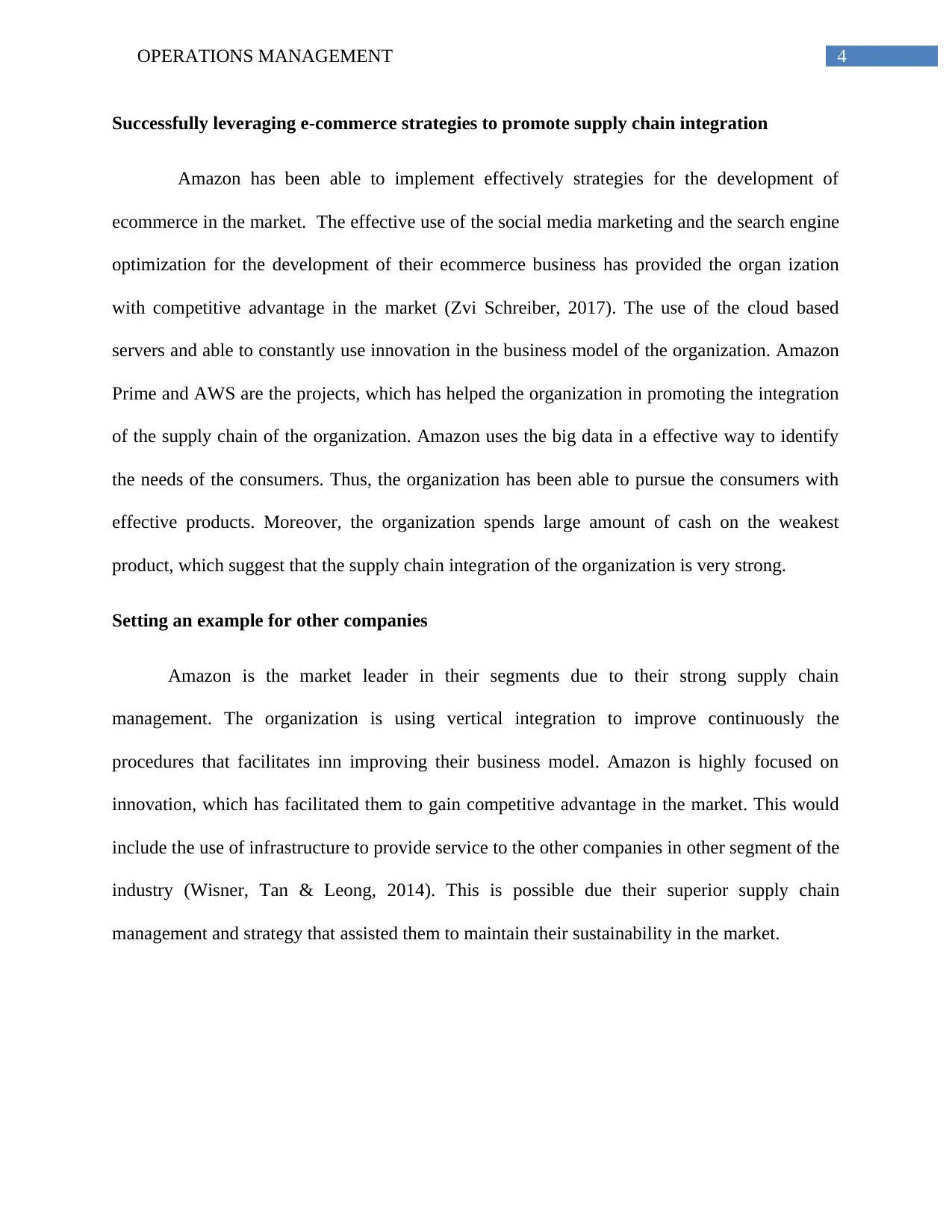
4OPERATIONS MANAGEMENT
Successfully leveraging e-commerce strategies to promote supply chain integration
Amazon has been able to implement effectively strategies for the development of
ecommerce in the market. The effective use of the social media marketing and the search engine
optimization for the development of their ecommerce business has provided the organ ization
with competitive advantage in the market (Zvi Schreiber, 2017). The use of the cloud based
servers and able to constantly use innovation in the business model of the organization. Amazon
Prime and AWS are the projects, which has helped the organization in promoting the integration
of the supply chain of the organization. Amazon uses the big data in a effective way to identify
the needs of the consumers. Thus, the organization has been able to pursue the consumers with
effective products. Moreover, the organization spends large amount of cash on the weakest
product, which suggest that the supply chain integration of the organization is very strong.
Setting an example for other companies
Amazon is the market leader in their segments due to their strong supply chain
management. The organization is using vertical integration to improve continuously the
procedures that facilitates inn improving their business model. Amazon is highly focused on
innovation, which has facilitated them to gain competitive advantage in the market. This would
include the use of infrastructure to provide service to the other companies in other segment of the
industry (Wisner, Tan & Leong, 2014). This is possible due their superior supply chain
management and strategy that assisted them to maintain their sustainability in the market.
Successfully leveraging e-commerce strategies to promote supply chain integration
Amazon has been able to implement effectively strategies for the development of
ecommerce in the market. The effective use of the social media marketing and the search engine
optimization for the development of their ecommerce business has provided the organ ization
with competitive advantage in the market (Zvi Schreiber, 2017). The use of the cloud based
servers and able to constantly use innovation in the business model of the organization. Amazon
Prime and AWS are the projects, which has helped the organization in promoting the integration
of the supply chain of the organization. Amazon uses the big data in a effective way to identify
the needs of the consumers. Thus, the organization has been able to pursue the consumers with
effective products. Moreover, the organization spends large amount of cash on the weakest
product, which suggest that the supply chain integration of the organization is very strong.
Setting an example for other companies
Amazon is the market leader in their segments due to their strong supply chain
management. The organization is using vertical integration to improve continuously the
procedures that facilitates inn improving their business model. Amazon is highly focused on
innovation, which has facilitated them to gain competitive advantage in the market. This would
include the use of infrastructure to provide service to the other companies in other segment of the
industry (Wisner, Tan & Leong, 2014). This is possible due their superior supply chain
management and strategy that assisted them to maintain their sustainability in the market.
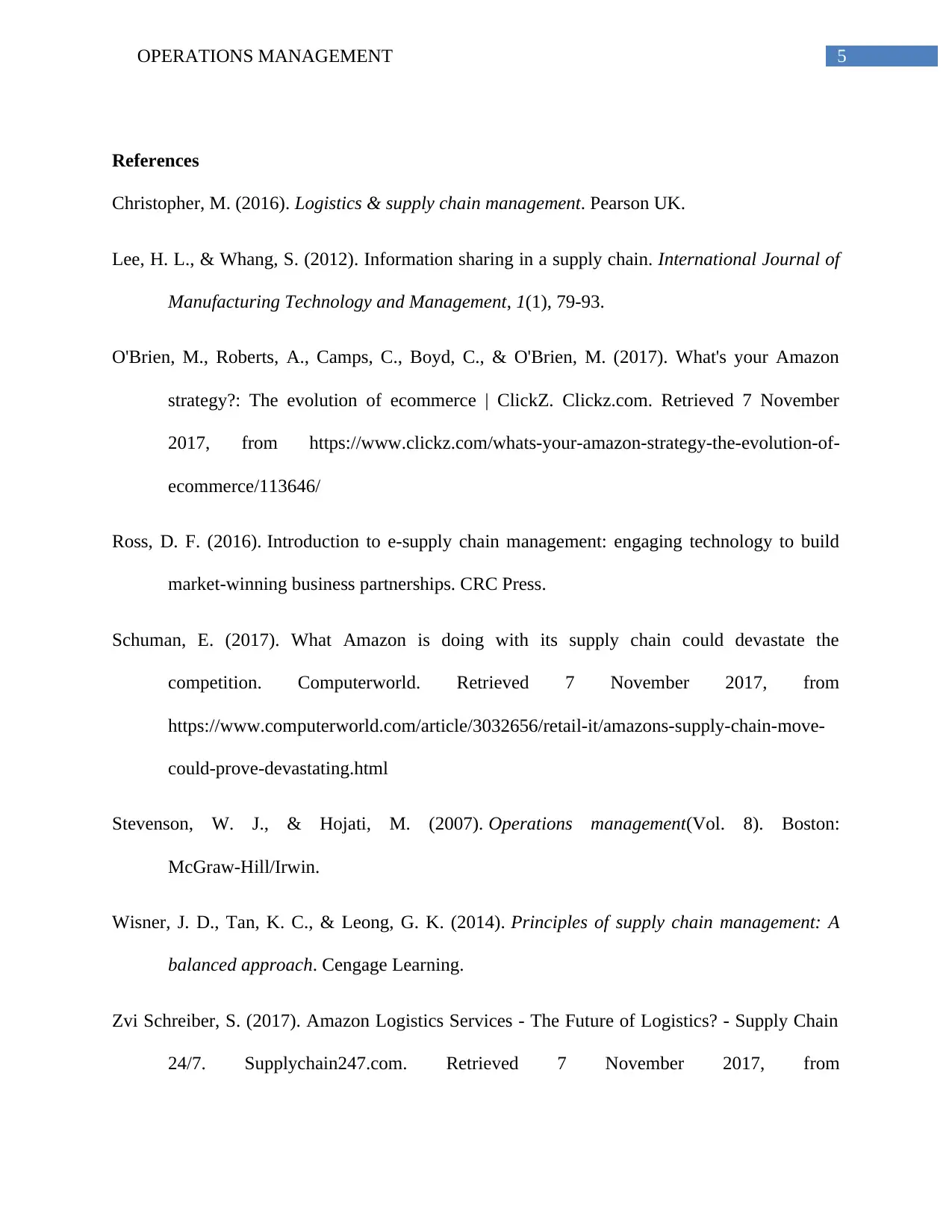
5OPERATIONS MANAGEMENT
References
Christopher, M. (2016). Logistics & supply chain management. Pearson UK.
Lee, H. L., & Whang, S. (2012). Information sharing in a supply chain. International Journal of
Manufacturing Technology and Management, 1(1), 79-93.
O'Brien, M., Roberts, A., Camps, C., Boyd, C., & O'Brien, M. (2017). What's your Amazon
strategy?: The evolution of ecommerce | ClickZ. Clickz.com. Retrieved 7 November
2017, from https://www.clickz.com/whats-your-amazon-strategy-the-evolution-of-
ecommerce/113646/
Ross, D. F. (2016). Introduction to e-supply chain management: engaging technology to build
market-winning business partnerships. CRC Press.
Schuman, E. (2017). What Amazon is doing with its supply chain could devastate the
competition. Computerworld. Retrieved 7 November 2017, from
https://www.computerworld.com/article/3032656/retail-it/amazons-supply-chain-move-
could-prove-devastating.html
Stevenson, W. J., & Hojati, M. (2007). Operations management(Vol. 8). Boston:
McGraw-Hill/Irwin.
Wisner, J. D., Tan, K. C., & Leong, G. K. (2014). Principles of supply chain management: A
balanced approach. Cengage Learning.
Zvi Schreiber, S. (2017). Amazon Logistics Services - The Future of Logistics? - Supply Chain
24/7. Supplychain247.com. Retrieved 7 November 2017, from
References
Christopher, M. (2016). Logistics & supply chain management. Pearson UK.
Lee, H. L., & Whang, S. (2012). Information sharing in a supply chain. International Journal of
Manufacturing Technology and Management, 1(1), 79-93.
O'Brien, M., Roberts, A., Camps, C., Boyd, C., & O'Brien, M. (2017). What's your Amazon
strategy?: The evolution of ecommerce | ClickZ. Clickz.com. Retrieved 7 November
2017, from https://www.clickz.com/whats-your-amazon-strategy-the-evolution-of-
ecommerce/113646/
Ross, D. F. (2016). Introduction to e-supply chain management: engaging technology to build
market-winning business partnerships. CRC Press.
Schuman, E. (2017). What Amazon is doing with its supply chain could devastate the
competition. Computerworld. Retrieved 7 November 2017, from
https://www.computerworld.com/article/3032656/retail-it/amazons-supply-chain-move-
could-prove-devastating.html
Stevenson, W. J., & Hojati, M. (2007). Operations management(Vol. 8). Boston:
McGraw-Hill/Irwin.
Wisner, J. D., Tan, K. C., & Leong, G. K. (2014). Principles of supply chain management: A
balanced approach. Cengage Learning.
Zvi Schreiber, S. (2017). Amazon Logistics Services - The Future of Logistics? - Supply Chain
24/7. Supplychain247.com. Retrieved 7 November 2017, from
⊘ This is a preview!⊘
Do you want full access?
Subscribe today to unlock all pages.

Trusted by 1+ million students worldwide

6OPERATIONS MANAGEMENT
http://www.supplychain247.com/article/amazon_logistics_services_the_future_of_logisti
cs
http://www.supplychain247.com/article/amazon_logistics_services_the_future_of_logisti
cs
1 out of 7
Related Documents
Your All-in-One AI-Powered Toolkit for Academic Success.
+13062052269
info@desklib.com
Available 24*7 on WhatsApp / Email
![[object Object]](/_next/static/media/star-bottom.7253800d.svg)
Unlock your academic potential
Copyright © 2020–2025 A2Z Services. All Rights Reserved. Developed and managed by ZUCOL.





